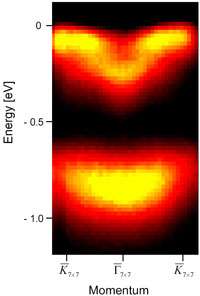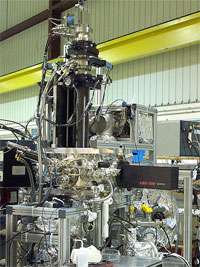Researchers Reveal New Insights into the Surface of Silicon Semiconductors

"Smaller. Faster. Wildly complex." This could easily be the motto for semiconductors—the materials that, among lots of other advances in electronics, allow cell phones to continuously shrink in size while increasing the number of their mind-boggling functions. While exceptionally tiny, semiconductors possess the ability to enable a multitude of complex functions, making them an invaluable ingredient in electronics technology. But, while the computer age is in full bloom, knowledge of semiconductor nanostructures is still relatively young; and research seeking to answer essential and sometimes-basic materials questions is occurring at breakneck speed.
As part of this race to understand semiconductors better, a team of researchers from the University of Wisconsin-Madison has revealed valuable information about Silicon and it's surface structure. In particular, the researchers, who did much of their work at the Synchrotron Radiation Center, examined the inimitable 7 x 7 surface structure of Si(111), the most stable surface of silicon.

"Surfaces and interfaces dominate in today's silicon devices, since the surface to volume ratio goes up in small structures. These two-dimensional structures are difficult to study, and the SRC work explores an aspect that has remained unexplored on semiconductors so far," explains one of the researchers, Ingo Barke, who, along with his collaborators at University of Wisconsin - Madison, published the results of their recent work in June 2, 2006 issue of Physical Review Letters.
"Our results reveal a very unusual surface band structure, which can be best explained by a mechanism called 'electron-phonon interaction,'" Barke continues. "Phonons are vibrations of the atoms, which are surrounded by electrons. By shaking the surface atoms the orbiting electrons 'feel' these vibrations and change their movement in a characteristic way. Our work connects two intensively studied fields: electron-phonon interaction which causes conventional superconductivity, and semiconductor surfaces which are of great importance for electronic devices and semiconductor technology."
While similar research has been done on metal surfaces, the current study is the first example of such examination on a semiconductor surface. Obviously, the researchers realize that studying the microscopic surface of silicon may seem rather esoteric. But, history has shown that these interesting jumps in basic knowledge about materials such as semiconductors can have significant practical impacts down the road—and this is particularly true in the case of silicon, which itself has become so inextricably important in modern society that it is credited with its own "silicon age."
"Electron-phonon interaction itself is of great scientific and practical interest because it is the key mechanism for conventional superconductivity," Barke notes while stressing that this knowledge may lead to the possibility of producing 'designer superconductors.'
"The ultimate goal lies in the possibility of tailoring," concludes Barke.
Reference: Barke, I., Zheng, F., Konicek, A.R., Hatch, R.C., and Himpsel, F.J. Electron-Phonon Interaction at the Si(111)-7 X 7 Surface. Physical Review Letters. 96, 216801 (2006).
Source: University of Wisconsin - Madison, by John Morgan




















